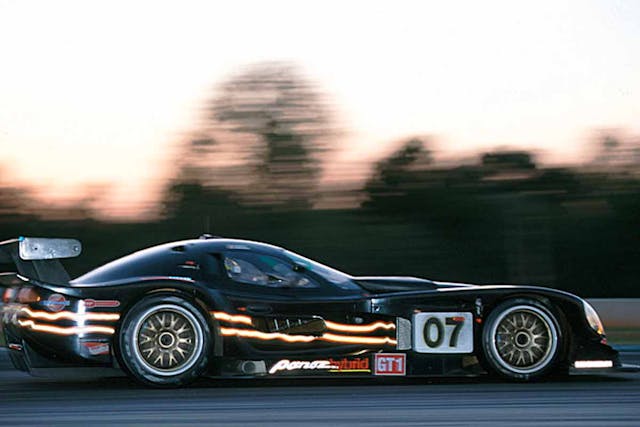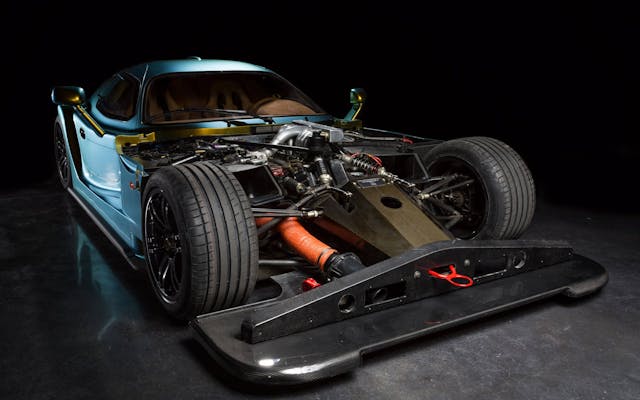5 chapters from the life of Don Panoz, automotive titan
Panoz is a name that’s woven so tightly into the fabric of motorsports that few even know it’s there tying everything together. Dr. Don Panoz was a true renaissance man, as he found its fortune in the pharmaceutical industry before turning his immense passion and resources into the American motorsports industry. His son, Dan, also grew interested in the automotive and racing industry.
The mark that the Esperante and the Roadster left behind are significant, but did you know that Panoz was responsible for a little grassroots racing series by the name of the American Le Mans Series? Or that he also ran a couple of podunk local tracks; maybe you’ve heard of Road Atlanta, Mosport, or Sebring?

The Roadster, a father-son endeavor
Dan Panoz began his automotive career at the short-lived Thompson Motor Company, an Irish sports car builder which sought to produce a Lotus 7 successor. The space-frame in the TMC Costin was the car’s strongest improvement on the 7’s recipe, but the company folded in 1988 with little to show for its efforts.
Dan saw an opportunity to start his own car company with the bones of TMC, purchasing the rights to the Costin’s chassis and head-hunting two former TMC employees: Mick Murphy, the head fabricator, along with engineer Sean Thompson. Together, they’d help morph the humble Frank Costin-designed sports car into a fire-breathing American missile. Not too dissimilar to Carroll Shelby’s hot-rodding of an AC Ace, the largest improvement Panoz made came from the acquisition of a small-block Ford.
While the TMC Costin was powered by an 84-horse Ford Kent four-banger, Panoz squeezed in the familiar Ford 5.0-liter V-8 from the Mustang. With Freeman Thomas fresh off a stint as a Senior Designer at Porsche, Panoz hired the young automotive stylist to create the new Roadster’s bodywork.
Bankrolled by his father, Don, Dan formed Panoz Auto Development in 1989. Assembly of the Roadster began the following year. Roadster production finished after 220 units built, most of which were powered by the later, all-aluminum 32-valve SVT Cobra V-8 in the Aluminum Intensive Vehicle (AIV) variant. This evolution of the Roadster integrated as much aluminum as possible at the time into the bodywork and chassis.

American Le Mans Series and IMSA
ALMS has been around long enough that most of us can’t remember a world without it. The bridge between American road racing and the French torture test has become synonymous with the yearly lead up to 24 Hours of Le Mans, but until the 1990s, there was little in the way of a connection between American and European racing.
IMSA was struggling from haphazard leadership, and a flood of competing road racing series fractured competition by the time Dr. Don Panoz came with his checkbook ready in 1999 to purchase the entire series. Founded by John and Peggy Bishop in 1959, the International Motor Sports Association (IMSA) had changed hands several times and assumed millions in debt by the 1990s. Don had moved his son’s humble street-car business into a full-effort attack on the 24 Hours of Le Mans, while the uniquely front-engined Panoz Esperante GTR-1 prototype car entered IMSA racing here in the States to shake out the new machine. Rumor has it that Dr. Panoz and IMSA’s owner, Andy Evans, had a bit of a falling out when Evans allegedly called the Esperante “a joke” after its debut at Sebring, where the new GTR-1 had a rocky start.
In 1998, Dr. Panoz had negotiated a deal to simply buy the entire IMSA operation, along with Mosport and Sebring. With a dream to bridge the gap between American motorsport and the 24 Hours of Le Mans, Panoz worked out an agreement with the race’s French organizers, the Automobile Club de l’Ouest (ACO). The plan was bring the Le Mans rule set stateside, allowing his crown jewel, the Petite Lemans at Road Atlanta, to be a local hub for North American racers. These competitors were seeking to build something for the 24 Hours of Le Mans but were previously restrained by the expense of investing into a setup that was otherwise illegal or irrelevant at their home series.
With his sharp business acumen, Panoz knew that simply pipelining rules wouldn’t be the only way to earn international respect. The experience had to have the same flair and sense of festivity that made Le Mans so iconic. The Château Élan resort near Road Atlanta was key to this effort; the event was centered around a fan-first focus to drum up excitement and prestige:
“I think most significant thing he did for the United States was that he recognized that there had never been a very clear and distinct connection with the biggest sports cars in the world, which is the 24 Hours of Le Mans,” says ALMS racer turned Trans-Am team owner Chris Dyson. “What Don realized was that there was an opportunity to bring the flavor and the experience of Le Mans several times a year at key events that had been always been features of racing schedules for decades.”
By 2012, IMSA’s parallel universe, Grand-Am (which had been created as a competitor to IMSA in 2000), merged to create the United SportsCar Championship. This funneled the wide scope of American endurance racing into a universal class structure, from the made-for-Le Mans prototypes to the cost-conscious Daytona Prototypes, and every conceivable mix of showroom-based GT touring classes. “When the sport was unified finally in 2012, I think a lot of Don’s vision finally came through,” Dyson tells us.

Mosport, Road Atlanta, Sebring
Don purchased Road Atlanta in his initial vision for Petit Le Mans, well before he aimed his money-raining laser beam on IMSA. After getting the keys to the track in 1996, Don outfitted the facility with millions in new infrastructure and buildings, as well as expanded capacity for larger races. A new, 100-foot tunnel into the infield allowed racers to access a second paddock area. New fan facilities were also built throughout the track, inching forward Don’s dream of capturing the spirit of the 24 Hours of Le Mans.
His acquisition of IMSA included Mosport, situated in Ontario, Canada, along with Sebring International Raceway, a course that grew from the WWII-era runways of Florida’s Hendricks Army Airfield. Both courses would also see significant investment in facilities and track surfaces. As part of his integration with ALMS, these three tracks continue to thrive thanks to the healthy mix of high-profile races with an atmosphere of prestige.
Drug Empire (the helpful kind)

Drug money had been used in racing in the past, but for Don Panoz, his means came through legitimate innovation: the creation of the nicotine patch. Don—who remained a life-long smoker despite the innovation on which he made his fortune—formulated the idea while watching a nurse treat his father with nitroglycerine. The nurse complained about being irritated by the fumes, and Don theorized he could make a patch that applied to a person’s skin with a sealed backing to keep the fumes contained. This would eventually spin into his solution to treat nicotine addiction and reduce cigarette smoking. After running into a disagreement with his business partner at Milan (now Mylan) Pharmaceuticals concerning follow-through with his addiction-beating transdermal patch, he left the company he co-founded to form Élan Corporation in Dublin, Ireland, in 1969. He was awarded a patent for the patch in 1986.
Don’s decision to move his operation from West Virginia to Ireland and start fresh would be eclipsed only by what he would do with Élan’s success. The Ohio-born son of Irish and Italian immigrants had built an immense amount of wealth and poured it into the industry his son, Dan, had pulled him into with the creation of the Panoz Roadster.
Ironically, Don smoked Silk Cuts—a company which famously sponsored Jaguar at Le Mans—until the day in 2018 that pancreatic cancer took his life, at the age of 83.
DeltaWing
Panoz Motor Sports’ “dare to be different” ethos behind the Esperante made a clear mark on Don, who adopted the radical DeltaWing for the 2012 season. Panoz and designer Ben Bowlby worked in tight partnership with Chip Ganassi Racing and Dan Gurney’s All American Racers to make the arrow-head race car come to fruition.
The DeltaWing was Bowlby’s alternative to the growing similarities between contemporary prototype cars, operating under the theory that by halving the weight and aerodynamic drag, you could get away with winning races on less horsepower, and thus, less fuel. The design was initially pitched as a new spec chassis for IndyCar, but after the committee denied it upon returning to Dallara, Panoz stepped in to convince the ACO that the DeltaWing deserved a spot in “Garage 56” as an experimental exhibition car.
The arrow-shaped DeltaWing thoroughly succeeded at its goal of improving fuel and tire consumption with its efficient design, but the attention to weight and tight packaging ended up contributing to the DeltaWing’s stalled development. Despite showing lap times that traded blows with the Prototypes in 2012, its first race in the experimental Garage 56 class was met by a door-slam from Toyota’s LMP1 entry, which promptly put it into the wall. “We’ve just got to win a goddamn race. To finish first, first you have to finish,” Don told Autoweek in 2016. “We have technology we want to prove—we don’t want to prove how quickly we can rebuild cars.”
Unfortunately for the legacy of the DeltaWing, Don would instead spend his time proving that his former partner, Bowlby, had been poached by Nissan to steal trade secrets about the DeltaWing program. The car’s future came to a fork in the road; Bowlby was ready to move on from the project while Don wished to build a streetcar out of the platform and continue racing it.
As the DeltaWing’s engine supplier, Nissan had a complicated and tepid relationship with the project but grew to understand that the narrow-track chassis had several advantages. In 2014, Nissan’s new EV Garage 56 entry, the ZEOD RC, looked suspiciously familiar to Panoz and Ganassi, spurring a lengthy legal battle over trade secrets that was settled amid undisclosed terms in 2016.


